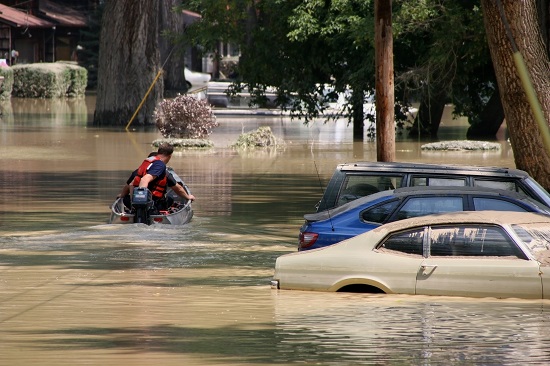An official website of the United States government
 United States Department of Labor
United States Department of Labor
| July 2018
Sara Hicks-West understands disasters. As a disaster director for the American Red Cross, she plans for and responds to hurricanes and other catastrophes. “It’s a very stressful environment,” says Hicks-West of working in the wake of a natural disaster.
But the job has its rewards, too. “To go into a shelter and know that there are individuals who are safe because of all the work you’ve put in, there’s great satisfaction in that,” she says.
People who work in disaster relief have a variety of jobs, but they all have a common mission: ensuring that when disaster strikes, help follows. Keep reading to find out more about careers in disaster relief.
Some workers, like Hicks-West, have full-time positions with a primary focus on disasters. Others have relief-related training or specialized skills but work full time in another job and are on call to help when disasters occur. And many other people volunteer or work in temporary jobs that last only until recovery efforts are complete.
Disaster relief work is commonly divided into four phases: preparedness, response, recovery, and mitigation.
Preparedness. During the preparedness phase, disaster relief workers develop and refine emergency response plans. They also conduct training exercises to get ready for a variety of possible scenarios.
Response. When disaster strikes, and in the days and weeks that follow, relief workers coordinate logistics for carrying out response plans. Workers take action to save lives, preserve property, and provide humanitarian care. They evacuate affected areas; set up shelters; restore power and repair other critical infrastructure; and deliver food, medicine, and other supplies.

Recovery. After meeting people’s immediate needs and restoring basic services, disaster relief workers help with economic recovery—including helping people get funding for repairs. Recovery workers help to address housing, health, and social services needs and assist in rebuilding communities.
Mitigation. To prevent or reduce damage from future disasters, relief workers do a variety of tasks in the affected community. These tasks include assessing possible weaknesses, taking steps to strengthen infrastructure, and educating the public about ways to lessen risks.
Emergency management agencies at the state and local level usually have a primary role in providing disaster relief in their communities. These agencies may be assisted by the federal government, nonprofit organizations, and, in some cases, private companies.
Among the federal agencies involved in coordinating disaster relief services are the Federal Emergency Management Agency (FEMA) and the U.S. Army Corps of Engineers. According to the U.S. Office of Personnel Management, those agencies employed 34,070 and 17,730 workers, respectively, in 2017.
BLS counts employment in nonprofit and private groups that provide relief under the “emergency and other relief services” industry (also referred to in some BLS data as the “community food and housing, and emergency and other relief services” industry). As chart 2 shows, employment in this industry more than doubled between 1990 and 2017, with continued growth projected through 2026.
Workers in community food and housing, and emergency and other relief services include those in management, community and social service, and delivery occupations, among others. Table 1 shows selected occupations for which BLS has data, sorted by 2017 median annual wage. (Compare wages in the table with $37,690, the median annual wage for all occupations in 2017.) Employment growth in relief services occupations is projected to be faster than the average for all occupations from 2016 to 2026.
Keep in mind that occupational data in the table are for a single industry and do not reflect all disaster relief employment. For example, less than 2 percent of emergency management directors are employed in community food and housing, and emergency and other relief services. Most emergency management directors work in government, with the remainder employed across several other industries, including hospitals and utilities.
In many ways, disaster relief work is unique. Workers may be on call for days or even weeks. And they must be prepared to travel on short notice—and expect long workdays of indefinite stay when they arrive.
Working conditions at a disaster site may be difficult because of both physical challenges, such as a lack of running water, and emotional ones, such as processing the sight of death or large-scale destruction.
Knowing that people’s lives and well-being may be at risk, along with the uncertainty of the disaster’s aftermath, adds to the stress of the work. “You do the best you can, but it might not always be enough,” says John Osborn of the National Disaster Medical System, a federally coordinated healthcare team.
However, a career in disaster relief can also be rewarding. People say they are drawn to relief work because they enjoy the challenges of responding to emergencies and the ambiguity that goes with it. They also like that no 2 days are alike, which keeps the work interesting.
Some workers find it inspiring to see varied groups and people coming together during a crisis to achieve a common goal. “It’s really rewarding to figure out that puzzle, to think on your feet and work with a team of people who are all aligned for that same purpose,” says Osborn.
Perhaps the most gratifying thing about relief efforts, workers say, is having an opportunity to improve the lives of people who may be in difficult, even desperate, situations. “There’s a direct connection,” says Laura Wolf, chief of the critical infrastructure protection branch at the U.S. Department of Health and Human Services, “between helping people and making sure that lives are saved.”
The education, experience, and training typically required to enter occupations related to disaster relief differs, as table 1 shows. But some skills and preparation are common among these workers.
For example, workers usually must have problem-solving skills and be able to adapt to changing scenarios—one relief event at a time. “Every disaster is unique,” says Wolf. “There are standard operating procedures, but the disaster is always going to challenge those. You have to think on your feet and be mentally resilient.”
Good communication and relationship-building skills are valuable, too, because disaster relief workers often coordinate with teams or individuals from both within and outside their own organization.

Disaster relief workers may choose to complete formal programs in emergency or disaster management, especially at the bachelor’s- and master’s-degree levels. Other credentials, such as the Certified Emergency Manager and the Certified Business Continuity Professional designations, may be required or preferred for some jobs. Still other training options may be available either in person or online, such as free courses offered by FEMA.
Many people learn different facets of relief work on the job, through experience in related positions, or by volunteering. For example, serving in the military, protective service, or certain healthcare occupations, such as EMTs and paramedics, provides a good foundation for dealing with emergencies.
Experiential learning is valuable preparation for any career, but it’s especially important in disaster relief. “You learn by doing, so you need to try as early and as often as you can to go to disasters,” says John Fredenberg, who works at the Centers for Disease Control and Prevention Division of Strategic National Stockpile. “In our field, lives literally hang in the balance.”
Learn more about the occupations in this article—and hundreds of others—including what workers do, what their job outlook is, what their entry-level education and training requirements are, and more in the Occupational Outlook Handbook.
Related Career Outlook articles include:
Working for the federal government
Helping those in need: Human service workers
Elka Torpey, "Careers in disaster relief," Career Outlook, U.S. Bureau of Labor Statistics, July 2018.